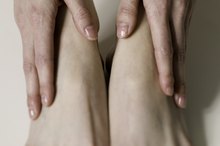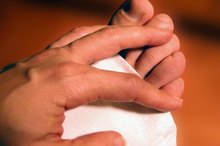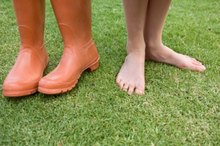What Causes Bruises All on the Bottom of My Feet When I Work Out or Walk Long Distances?
You feel like you've been walking over rocks and your feet look that way. You've got noticeable bruises on the bottom of your feet -- or maybe tender and swollen areas that just feel like bruises. Your best option is resting your bruised feet and icing them four times a day for about 10 minutes. Most conditions that contribute to bruised feet will eventually get better with rest and new, sturdy and supportive shoes. However, bruises that don't heal should be evaluated by a doctor, because bruised feet can be a sign of diabetic neuropathy and other similar conditions.
If you are experiencing serious medical symptoms, seek emergency treatment immediately.
Bruised Sesamoids
Bruises that develop primarily on the ball of the foot may be the result of broken or bruised sesamoids, which are tiny bones that connect the foot to the toes. Though they can be painful, bruised sesamoids are considered warning signs that your big toe and your other toes may be in danger of experiencing significant damage. A running stride that has you landing on the balls of your feet instead of the middle of your feet can be to blame. Ice your bruised feet and ask a knowledgeable runner to look at your stride and see if you can make adjustments that won't impact your feet so severely.
- Bruises that develop primarily on the ball of the foot may be the result of broken or bruised sesamoids, which are tiny bones that connect the foot to the toes.
- Though they can be painful, bruised sesamoids are considered warning signs that your big toe and your other toes may be in danger of experiencing significant damage.
Blood Blisters
When to See a Podiatrist for Cracked Heels
Learn More
Unlike a typical blister that forms under the very outer layers of the skin and often breaks the skin before it heals, a blood bluster forms beneath bruised skin in an area where small a blood vessel is injured also. If you continue to walk long distances, run or exercise hard on a blood blister, you risk bruising it or breaking it open, which in turn increases the risk of infection. If a blood blister or any foot bruise breaks the skin, treat it with disinfectant immediately and cover it as much as possible to keep it clean. Stores that feature running shoes often carry blister pads, which can be handy if you see a bruise or blister forming.
- Unlike a typical blister that forms under the very outer layers of the skin and often breaks the skin before it heals, a blood bluster forms beneath bruised skin in an area where small a blood vessel is injured also.
- If you continue to walk long distances, run or exercise hard on a blood blister, you risk bruising it or breaking it open, which in turn increases the risk of infection.
Unseen Bruises
You may experience sore spots along the bottom of your feet, but see no discoloration. Such symptoms, which may be associated with tenderness or slight swelling, could indicate a condition known as metatarsalgia or "stone bruises." Rest and ice on the affected foot, as well as better running shoes -- and possibly inserts to provide better midsole cushioning -- may be enough to relieve any symptoms.
The Wrong Footwear
A Blood Clot in the Big Toe
Learn More
Your feet can become bruised simply by wearing the wrong shoes while you walk a long way or spend a lot of time exercising in them. If you know you're going to be on your feet for an extended period, forgo boots, high heels and other stylish, yet punishing footwear in favor of sensible shoes that provide sturdiness and support.
Related Articles
References
- American Academy of Podiatric Sports Medicine: What is a "Stone Bruise" and How is it Treated?; By Phyllis A. Ragley, DPM
- American Academy of Dermatology. How to prevent and treat blisters.
- Hoffman MD. Etiological foundation for practical strategies to prevent exercise-related foot blisters. Curr Sports Med Rep. 2016;15(5):330-5. doi:10.1249/JSR.0000000000000297
- Caselli MA, Chen-Vitulli J. Foot blister prevention: What you can recommend to athletes. Podiatry Today. 2002;15(4):68-69.
- Mailler EA, Adams BB. The wear and tear of 26.2: dermatological injuries reported on marathon day. Br J Sports Med. 2004;38(4):498-501. doi:10.1136/bjsm.2004.011874
- Worthing RM, Percy RL, Joslin JD. Prevention of friction blisters in outdoor pursuits: A systematic review. Wilderness Environ Med. 2017;28(2):139-149. doi:10.1016/j.wem.2017.03.007
Writer Bio
James Roland started writing professionally in 1987. A former reporter and editor with the "Sarasota Herald-Tribune," he currently oversees such publications as the "Cleveland Clinic Heart Advisor" and UCLA's "Healthy Years." Roland earned his Bachelor of Science in journalism from the University of Oregon.









